I haven’t talked too much yet about why the Traditional City works, and other designs do not. I figured you would just get the message from the photos — it’s pretty obvious isn’t it? However, since we are aiming here not only to be a diner who can say “mmmm — yummy!” but actually a chef who knows exactly how to make that effect, let’s talk more about how the Traditional City works.
我还没有过多地讨论为什么传统城市设计可行,而其他设计不可行。我想你们从照片上就能明白--这很明显,不是吗?不过,既然我们在这里的目标不仅仅是成为一个会说 "嗯--好吃!"的食客,而是要成为一个确切知道如何做出这种效果的厨师,那就让我们来详细谈谈传统城市是如何运作的吧。
“There’s no there there,” said Gertrude Stein famously about Oakland, California. She was speaking on a vague, aesthetic level, but it is also true on a physical, square-feet kind of level too. I say that there are two kinds of sqare-footage in a city: Places and Non-Places.
格特鲁德-斯坦因(Gertrude Stein)在谈到加利福尼亚州奥克兰市时曾说过一句名言:"那里没有任何东西"。她说的是一个模糊的、审美的层面,但在物理的、平方英尺的层面上也是如此。我说,一个城市有两种平方英尺:场所和非场所。
Places are areas where things happen. This includes:
场所是发生事情的地方。这包括
Houses 房屋
Offices 办事处
Factories 工厂
Warehouses 仓库
Beaches 海滩
Marinas 游艇码头
Parks 公园
Museums 博物馆
Restaurants 餐厅
Shops 商店
Theaters 影院
Schools 学校
Hotels 酒店
Sports fields 运动场
Train stations 火车站
Plazas/central squares 广场/中心广场
Gardens/yards/courtyards
花园/庭院/庭院
In short, if you “do something,” like work or sleep or go shopping or have a picnic or a party, it’s the place where you do it. A destination. The location where people interact. Places are universally pedestrian places. Nothing happens while people are in their cars. Cars are just the means to get from one Place to another Place.
简而言之,如果你 "做某事",比如工作、睡觉、购物、野餐或聚会,它就是你做这些事的地方。目的地。人们互动的场所。场所一般都是步行的地方。人们在车里的时候,什么都不会发生。汽车只是从一个场所到达另一个场所的工具。
Non-Places are areas of the city where nothing happens. This includes:
非场所是指城市中不发生任何事情的区域。这包括
Parking lots 停车场
Useless greenery (not a park, but landscaping where nobody goes)
无用的绿化(不是公园,而是无人问津的园林景观)
Roadways and other transportation infrastructure
道路和其他交通基础设施
Areas around buildings which are not “destinations,” and often have no real purpose
建筑物周围不是 "目的地 "的区域,通常没有实际用途
I think you understand exactly what I’m talking about. Notice that almost every area is easily categorized as one or the other. There aren’t many exceptions.
我想你完全明白我在说什么。请注意,几乎每个领域都很容易被归类为二者之一。没有多少例外。
When more and more of a city consists of Places, then there’s “more there there,” as Gertrude Stein might say. When most of a city consists of Non-Places, then there’s “less there there,” until finally there is “no there there.”
正如格特鲁德-斯坦因(Gertrude Stein)所说,当一个城市越来越多地由 "场所 "组成时,"那里就会有更多"。当一个城市的大部分由 "非空间 "组成时,"那里的空间越来越少",直到最后 "那里没有空间"。
That’s it! It’s as simple as that.
就是这样!就是这么简单。
So, obviously, we want to maximize our Places and minimize our Non-Places, if we want to have a successful outcome.
因此,很明显,如果我们想要取得成功,就必须最大限度地利用 "场所",最大限度地减少 "非场所"。
If we look at the Traditional City, we see that it is mostly Places. To the degree that we can eliminate cars, the Traditional City can become almost 100% places.
如果我们看一下传统城市,就会发现它主要是 "场所"。如果我们能够消除汽车,传统城市几乎可以变成 100% 的 "场所"。
A pedestrian street is a Place. When it becomes dominated by cars — to the point where a person is not comfortable walking down the middle of the street — it becomes a Non-Place. This doesn’t mean that you have to ban automobiles completely. You can have automobile access, which will be necessary for deliveries and the occasional taxi, but the street can still be dominated by pedestrian activity. I mentioned that 90% of the streets in Tokyo have no cars on them. This is not because it is forbidden, but because it’s damn difficult to drive a car on a Really Narrow Street, and nobody really needs to anyway.
步行街就是一个场所。当步行街被汽车占据--以至于一个人走在马路中间都不舒服--它就变成了一个非场所。这并不意味着必须完全禁止汽车通行。你可以有汽车通道,这对送货和偶尔的出租车来说是必要的,但街道仍然可以以行人活动为主。我曾提到,东京 90% 的街道上都没有汽车。这并不是因为禁止汽车通行,而是因为在真正狭窄的街道上驾驶汽车非常困难,而且也没有人真的需要驾驶汽车。
Some people may disagree with my characterization of roadways, but a car-dominated roadway (as opposed to a pedestrian Really Narrow Street) is really transportation infrastructure no different than a rail line. It is noisy and stinky and dangerous and completely hostile to humans (“pedestrians”), just like a rail line. I think it is best to put the transportation infrastructure — in my examples a subway system — entirely underground, which allows the Traditional City to attain its traditional ratio of 100% Places.
有些人可能不同意我对道路的描述,但以汽车为主的道路(相对于行人专用的窄街)实际上是与铁路线无异的交通基础设施。它嘈杂、恶臭、危险,与铁路线一样,对人类("行人")完全不友好。我认为最好将交通基础设施--在我的例子中是地铁系统--完全置于地下,这样传统城市就能达到其传统的 100%"广场 "比例。
If you look at all the streets that are destinations, like Rodeo Drive or the Champs Elysees, or Madison Avenue and so forth, the places where people say: “let’s go to XXX”, they are all pedestrian places. Probably with shopping involved. There might be cars too — a lot of them — but nobody is saying “let’s go stand in the middle of traffic on Madison Avenue,” they are talking about the pedestrian places. If you could get rid of the automobile roadways — for example, connect the two sidewalks of Madison Avenue to make a pedestrian street about 25 feet wide from building to building — it would be just as much of a destination, maybe more so.
如果你看看所有作为目的地的街道,比如罗迪欧大道、香榭丽舍大街、麦迪逊大道等等,人们会说 "我们去 XXX 吧 "的地方:"我们去 XXX 吧 "的地方,它们都是步行街。可能还有购物场所。可能也有汽车--很多汽车--但没有人会说 "我们去麦迪逊大道的车流中间吧",他们说的都是步行街。如果能取消汽车道--例如,将麦迪逊大道的两条人行道连接起来,形成一条宽约 25 英尺的步行街,从一栋楼到另一栋楼--那么这里同样会成为一个旅游景点,甚至会更受欢迎。
One of the biggest and most destructive Non-Places in cities today is Green Space. Note that it is always termed “green space.” It is not a park, or a backyard, or a sports field, or even a wholly natural area like a forest. If people were talking about parks, they would say: “we have plenty of parks.” But they don’t say that, they say: “we have plenty of Green Space.” Green Space is not a place where things happen. Do you ever say: “Let’s get the kids together and have a picnic in that grassy area between the northbound and southbound I-95.” No, that never happens. How about: “Let’s go play soccer in that grassy area by the Wal-Mart parking lot.” These are things that happen in parks and sports fields, which are traditional components of the Traditional City, not Green Space.
当今城市中最大、最具破坏性的 "非空间 "之一就是绿地。请注意,它总是被称为 "绿地"。它不是公园,不是后院,不是运动场,甚至不是森林之类的完全自然的区域。如果人们谈论公园,他们会说:"我们有很多公园"但他们不会这么说,他们会说:"我们有很多绿地"绿地不是发生事情的地方你有没有说过"让我们把孩子们召集起来 在95号公路南北方向之间的草地上野餐吧"没有,从来没有过。那么"我们去沃尔玛停车场旁边的草地上踢足球吧"这些都是发生在公园和运动场上的事情,是传统城市的传统组成部分,而不是绿地。
Green space is a new invention. What’s it for? Green Space was invented to make our other Non-Places less horrible. It basically doesn’t exist in the Traditional City.
绿地是一项新发明。它是用来做什么的?绿地的发明是为了让我们的其他非空间变得不那么可怕。在传统城市中,绿地基本上是不存在的。
One of the basic problems with Non-Place is that it’s contagious. When you start introducing Non-Places into a city design, you tend to add more and more Non-Places to try to fix the problems caused by the original Non-Places. If you have two Places next to each other, like an apartment building and a store, then you can easily walk from the apartment building to the store. If you put a big roadway in between, now you can no longer walk. You need a car. Now the apartment building needs a parking lot. Now the store needs a parking lot. Now the roadway needs to get bigger because of all the people driving from the apartment to the store. Now you need to surround the apartment building with grass (or better yet, a row of trees) to add a little buffer between the apartment building and the noisy roadway, because who wants to live next to a roaring highway? Then, you need to surround all the parking spaces with more grass and shrubbery, so that you aren’t left with acres of burning asphalt. Then, the apartment building and the store are now so far from each other that you decide you need a freeway system. Then, because you have to drive the on/off ramps at 50 miles per hour, they need to have an enormous radius, and then they need to be surrounded by more green space and probably a cinder block wall so that people can tolerate the endless noise of a major freeway. Then, your city fills up with gasoline stations, car dealers, mechanics, auto parts stores, and all the paraphernalia needed to maintain all this transportation infrastructure. It is quite possible that your portion of Place to Non-Place in the city will fall below 10%. Essentially, the only Places left will be building interiors and a few parks (minus their parking lots).
非空间的一个基本问题是它具有传染性。当你开始在城市设计中引入 "非空间 "时,你往往会添加越来越多的 "非空间 "来试图解决原有的 "非空间 "所带来的问题。如果两个 "空间 "相邻,比如一栋公寓楼和一家商店,那么你可以很容易地从公寓楼走到商店。如果在这两个 "场所 "之间修建一条大路,你就不能再步行了。你需要一辆车。现在,公寓楼需要一个停车场。现在商店需要一个停车场。现在,由于从公寓开车到商店的人太多,道路需要变得更大。现在,你需要在公寓楼周围种上草坪(或者最好种上一排树),在公寓楼和嘈杂的道路之间增加一点缓冲,因为谁愿意住在咆哮的高速公路旁边呢?然后,你需要在所有停车位周围种上更多的草和灌木,这样就不会只剩下一大片燃烧的沥青了。然后,公寓楼和商店现在相距甚远,你决定需要一个高速公路系统。然后,由于你必须以每小时 50 英里的速度驾驶上下匝道,它们需要有一个巨大的半径,然后它们需要被更多的绿地和可能是煤渣砖墙所包围,这样人们才能忍受大型高速公路无休止的噪音。然后,加油站、汽车经销商、机械师、汽车配件商店以及维护所有这些交通基础设施所需的所有辅助设施就会充斥你的城市。城市中的 "场所 "与 "非场所 "的比例很可能会低于 10%。从根本上说,剩下的 "场所 "将只有建筑内部和一些公园(不包括停车场)。
One of the things you’ll notice about the Traditional City is that there is often not a lot of greenery in them. This might be considered a genuine problem. I would be all for greenery in the Traditional City, in the form of parks (concentrated greenery) and also just bits of flowers and trees here and there. However, the Traditional City can still be just fine — in fact quite wonderful — without this greenery. How much greenery is in Siena, Italy?
你会注意到传统城市的一个特点,那就是绿化往往不多。这可能确实是个问题。我非常支持在传统城市中进行绿化,绿化的形式可以是公园(集中绿化),也可以是零星的花草树木。不过,没有这些绿化,传统之城也可以很好,事实上是非常棒的。意大利锡耶纳有多少绿色植物?
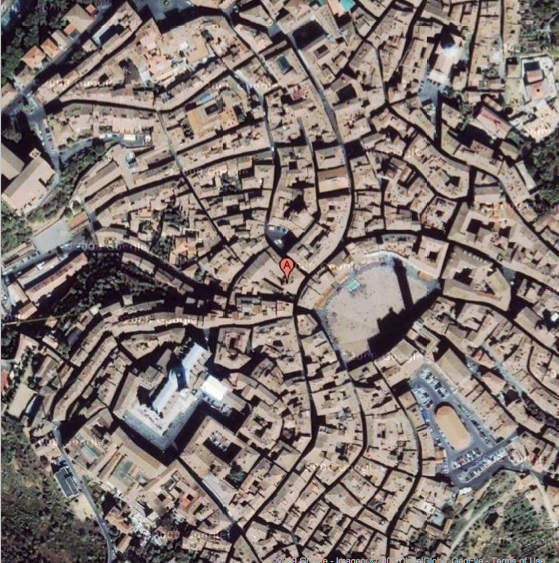
(There is essentially no Non-Place at all in this photo.)
(这张照片中基本上没有 "非地点")。
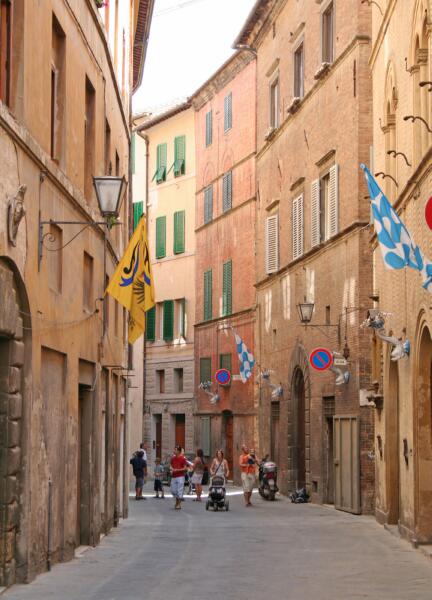
Not only are there hardly any parks to speak of, but on street level, you would have to get out a magnifying glass to find even the slightest trace of vegetation.
不仅几乎没有公园可言,而且在街道上,你必须拿出放大镜才能找到哪怕一丁点植被的痕迹。
I don’t think Siena is the best possible Traditional City. But, along with Florence, it is a place that people have been traveling to for about 200 years because of its reputation as an urban concrescence of beauty and culture. Obviously, it appeals to people. Out of all the millions of tourists over the years, how many have collapsed in a heap, writhing in agony because of the shortage of Green Space? Exactly none. The Traditional City doesn’t need Green Space. Apparently, not even a single blade of grass — although a few parks here and there should probably be considered an improvement.
我不认为锡耶纳是最好的传统城市。但是,锡耶纳和佛罗伦萨一样,是人们 200 年来一直向往的地方,因为它被誉为美景和文化的城市浓缩。显然,它对人们很有吸引力。多年来,在数以百万计的游客中,有多少人因为绿地不足而倒下,痛苦地挣扎?一个也没有。传统城市不需要绿地。显然,甚至连一片草地都不需要--尽管在这里和那里建几个公园应该算是一种进步。
The Traditional City doesn’t need Green Space because it doesn’t suck to begin with. There is no problem we are trying to solve through the introduction of acres of mowed lawns.
传统城市不需要绿地,因为它本来就不差劲。我们并没有试图通过引入数英亩修剪过的草坪来解决问题。
The Traditional City doesn’t have to be devoid of vegetation. With the addition of only a rather small amount of trees and plants, it can become quite lush and verdant.
传统城市并不需要没有植被。只需增加少量的树木和植物,它就能变得郁郁葱葱。
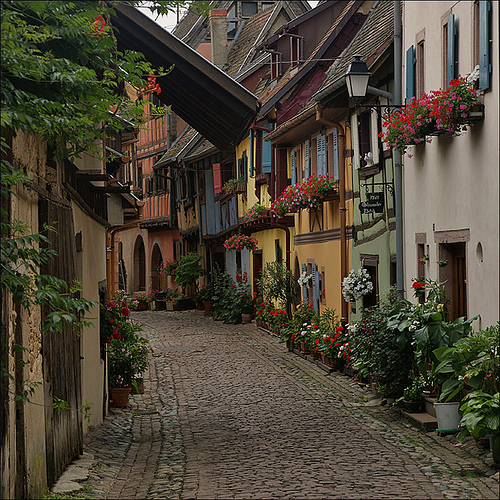
SONY DSC 索尼 DSC
This looks like a profusion of verdure, but actually there are just a few window boxes and potted plants. It’s almost nothing at all. The reason it seems so lush is that we don’t have to compensate for some kind of off-screen horror, like six lanes of roaring traffic. Note that there is not a single square inch of Non-Space in this photo.
这里看起来绿意盎然,但实际上只有一些窗台和盆栽。几乎什么都没有。之所以看起来如此茂盛,是因为我们不必为屏幕外的恐怖景象(比如六车道咆哮的车流)做出补偿。请注意,这张照片中没有一平方英寸的 "非空间"。
At this point, there are always the literalists who want to know the exact species of red and pink flower used in the window boxes, as if that was the secret. It’s totally irrelevant! Grow marijuana in your window boxes if you want. The important thing is the Really Narrow Street, and its natural consequence, the elimination of auto traffic. Then, you want the buildings side-by-side, which eliminates the potential Non-Space between buildings. When you get that right, then you can add a little bit of whatever plant you like, and get a wonderful result.
在这一点上,总有一些文字主义者想知道窗台上用的红色和粉色花朵的具体品种,似乎这就是秘密所在。这完全无关紧要!如果你愿意,可以在窗台上种大麻。重要的是 "真正的窄街 "及其自然结果,即消除汽车交通。然后,你希望建筑物并排而建,这就消除了建筑物之间潜在的非空间。当你做到这一点时,你就可以添加一些你喜欢的植物,并得到一个美妙的结果。
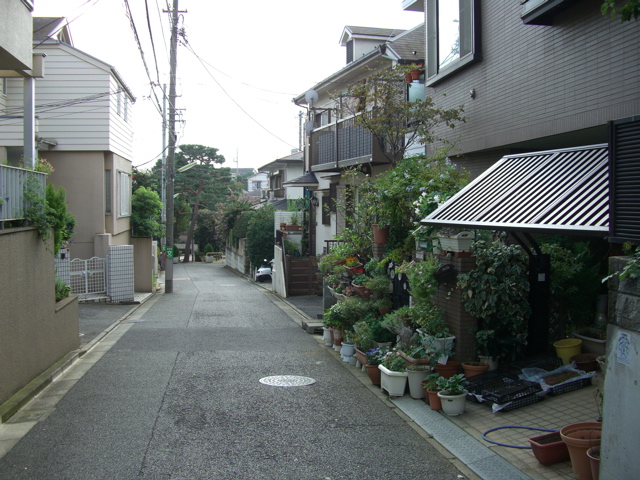
Here we have a completely different situation. This is eight thousand miles east, with buildings that date from the 1980s or so. This is not an antiquarian relic in the country, it is one of the most desirable neighborhoods of one of the wealthiest cities on the planet. Nevertheless, the result is just fine. You noticed that the street width is almost identical, right? It’s about eight feet. This is central Tokyo, namely the Yoyogi area just west of Meiji Jingu shrine — NOT a suburb. You can walk from here to either Shibuya or Shinjuku, both major downtown commercial districts. Many, many Tokyo urban residential areas look like this. These are single-family detached residences, also known as townhouses. Many have small backyards and gardens. Apartments are not strictly necessary, and in fact the first multifamily apartment building in Tokyo wasn’t built until the 1920s. (It was on Omote-Sando boulevard and was recently torn down. Yes — that one.) Once again, not a single square inch of Non-Space here. Add a subway station (in this case, the Yoyogi-Uehara station on the Chiyoda subway line), and you are done.
这里的情况完全不同。这里位于东面八千英里处,建筑物的历史可以追溯到 20 世纪 80 年代左右。这不是一个国家的古迹,而是地球上最富有的城市中最令人向往的街区之一。尽管如此,结果还是不错的。你注意到街道的宽度几乎是一样的吧?大约八英尺。这里是东京市中心,即明治神宫以西的代代木地区,而不是郊区。从这里可以步行到涩谷或新宿,这两个都是市中心的主要商业区。很多很多东京市区的住宅区都是这样的。这些都是独门独户的住宅,也称为联排别墅。很多都有小后院和花园。事实上,东京的第一座多户公寓楼直到 20 世纪 20 年代才建成。(它位于大表参道林荫大道上,最近被拆毁了。 是的,就是那座)再次说明,这里没有一平方英寸的非空间。再加上一个地铁站(这里是地铁千代田线的代代木上原站),就大功告成了。
That’s it! That’s all there is to it.
就是这样!就是这样
It’s soooooo easy. 太简单了
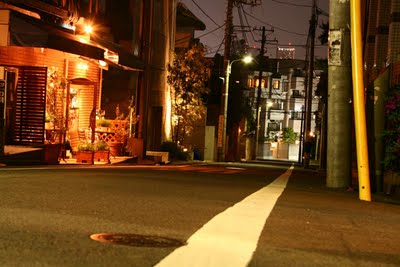
The walk down to Yoyogi-Uehara station.
步行前往代代木上原站。
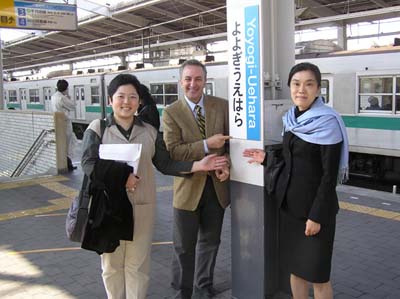
Some local people obviously happy that they don’t live in Suburban Hell.
一些当地人显然为自己不住在郊区地狱而感到高兴。
“Now THIS is an electric vehicle!”
"这才是电动汽车!"
It is difficult to explain, to someone who has never experienced it, that the Traditional City is actually a very quiet, lovely sort of place — even the largest Traditional Cities, with the Tokyo population well over 30 million. Many of our common assumptions about urban environments don’t apply. It doesn’t stink because there are no cars. (Fortunately, we are beyond the coal-burning age, and have good sanitation today.) It isn’t “noisy,” because it’s the cars making the noise, not people walking around. It isn’t “crowded,” even if there are lots of people, because what people usually mean by “crowded” is that there is lots of automobile traffic. The only way to solve these problems is to dump the cars. Most of what people don’t like about cities today is actually caused by automobiles. The residential university campus is about the closest experience most Americans have to a no-car urban place. There were lots of people at the university, but was it “crowded”? Never happens. How about the indoor mall — which is an approximation of a Traditional City shopping area. In fact, most people are attracted to those places that have lots of other people. It’s where the party is.
很难向从未体验过传统城市的人解释,传统城市其实是一个非常安静、可爱的地方--即使是东京人口远超 3000 万的最大传统城市。我们对城市环境的许多常见假设并不适用。因为没有汽车,所以没有臭味。(幸运的是,我们已经过了烧煤的时代,如今有了良好的卫生条件)。它不 "嘈杂",因为发出声音的是汽车,而不是走动的人。即使有很多人,也并不 "拥挤",因为人们通常所说的 "拥挤 "是指有很多汽车通行。解决这些问题的唯一办法就是把汽车扔掉。如今人们对城市的不满,大部分其实都是由汽车造成的。大学校园是大多数美国人最接近无车城市的地方。大学里有很多人,但 "拥挤 "吗?从来没有。室内购物中心怎么样?事实上,大多数人都喜欢去人多的地方。那里才是聚会的地方。
Practically everyone these days talks about Green Space as a necessary element of their ideal city. You even see people boasting about it, as in “45% of our Sustainable City of the Future consists of Green Space.” They are hinting: “You have a big vegetation buffer between you and the rest of Suburban Hell.” Which is, actually, desirable if you are living in Suburban Hell.
如今,几乎每个人都把绿地作为理想城市的必要元素。你甚至会看到有人夸耀这一点,比如 "我们可持续发展的未来城市有 45% 是由绿地组成的"。他们在暗示"你和地狱郊区的其他地方之间有一个很大的植被缓冲区"。实际上,如果你生活在地狱郊区,这也是可取的。
I consider Green Space to be absolute poison.
我认为绿地绝对是毒药。
The rule of “Non-Places are contagious” also applies to Green Space. If you start adding Green Space everywhere, pretty soon you are going to need cars to get here and there. Then come the roadways and parking lots. Then comes more Green Space to make the roadways and parking lots a little less horrible.
非空间会传染 "的规则同样适用于绿地。如果你开始到处增加绿地,很快你就会需要汽车来来往往。然后是道路和停车场。然后是更多的绿地,让道路和停车场变得不那么可怕。
I don’t think many people realize how much this poisonous Green Space concept has infected our ideas of how to build cities. For example:
我想很多人都没有意识到,这种有毒的 "绿地 "概念对我们建设城市的理念有多大的影响。例如
Clackamas County, Oregon.
俄勒冈州克拉克马斯县。
Title 12: Zoning and Development Ordinance.
第 12 篇:分区与发展条例
Section 1000: Development Standards.
第 1000 节:开发标准。1009 Landscaping, 1009.02 Minimum Area Standard
1009 景观美化, 1009.02 最小面积标准The minimum area requirements may include landscaping around buildings and in parking and loading areas, outdoor recreational
最小面积要求可包括建筑物周围、停车场和装卸区、室外休闲区以及本节 (1009) 所要求的缓冲区。
use areas, and buffering as required under this section (1009).
使用区,以及本节 (1009) 所要求的缓冲区。A. Medium and High Density Residential: A minimum of twentyfive (25) percent of the gross land areas shall be used for landscaping in medium and high density districts. This requirement may be reduced to a minimum of twenty (20) percent when the development qualifies for bonus density under subsection 1012.040 for Site Planning and Design Excellence. Redevelopment or additions to multifamily developments shall meet the minimum area requirements of this section.
A.中高密度住宅区:在中密度和高密度区,应将至少百分之二十五(25%)的土地总面积用于美化环境。如果开发项目符合 1012.040 小节规定的 "优秀场地规划与设计 "奖励密度要求,则该要求可减至至少百分之二十(20%)。多户开发项目的重建或扩建应满足本节规定的最低面积要求。
So, right off the bat, a minimum of 25% of our “medium and high density residential” area becomes a Non-Place — this before the parking and the roadways. Instant disaster. Instant automobile dependence.
因此,一开始,我们至少有 25% 的 "中高密度住宅区 "变成了 "非居住区"--这还不算停车场和道路。瞬间灾难。对汽车的瞬间依赖。
The funny thing is, a whole legion of urban planning troglodytes think this Green Space is “sustainable,” that word which is magic fairy dust meaning almost nothing. If Non-Space leads to automobile dependence, and automobiles are not “sustainable” (arguably), then obviously, Green Space is the exact opposite of what you would want to do if you were really aiming at “sustainability” (whatever that means this week). Look at this paper to see what I mean:
有趣的是,一大批城市规划的迂腐者认为这种绿色空间是 "可持续的",这个词就像神奇的仙粉,几乎没有任何意义。如果 "非空间 "会导致对汽车的依赖,而汽车又不是 "可持续的"(可以这么说),那么很明显,如果你真的想实现 "可持续发展"(不管这周是什么意思),"绿色空间 "与你想做的正好相反。看看这篇论文就知道我的意思了:
Trees, Parking and Green Law: Strategies for Sustainability
树木、停车场和绿色法律:可持续性战略
You don’t really have to read much beyond the title. It perfectly describes how laughably fucked-up City Design is today, even among apparently well-meaning specialists. You might as well write a paper called: “Guns, Bombs and Imperial Ambition: Strategies for Peace.”
除了标题之外,你不必读太多。它完美地描述了当今的城市设计是多么令人啼笑皆非,即使是在那些看似善意的专家中间也是如此。你还不如写一篇论文"枪炮、炸弹和帝国野心:和平战略"
Here’s another one. It’s everywhere:
这里还有一个。随处可见:
Creating Sustainable Communities: Delivering Greenspace in the Thames Gateway
创建可持续社区:在泰晤士河门户提供绿地
Don’t you love that terminology? “Delivering Greenspace.” Like it was a commodity that flows down a pipe. How about “Build a Park?” And what is so goddamn “sustainable” about “greenspace”? Do you plan to graze goats or something?
你不喜欢这个术语吗?"交付绿地"就好像它是顺着管道流淌的商品一样。"建一个公园 "怎么样?"绿地 "有什么好 "可持续 "的?你是打算放牧山羊还是什么?
I think a lot of these people actually plan to graze goats in the middle of the city. It is an idea buried in their mind. We should make them actually keep goats for a year. That should solve the problem.
我觉得这些人中有很多人真的打算在城市中央放牧山羊。这是埋藏在他们心中的一个想法。我们应该让他们真正养一年山羊。这样就能解决问题了。
You know what Ben Franklin would say:
你知道本-富兰克林会怎么说:

“Fuck goats.” "去他妈的山羊"
April 19, 2009: Let’s Kick Around the “Sustainability” Types
2009 年 4 月 19 日让我们一起探讨 "可持续性 "类型
Parks are fine, even very large parks like Central Park in New York — which is absolutely a Place, not a Non-Place. While the Traditional City can work well with almost no parks at all, I think you can devote up to 20% of the surface area to parks with an overall positive effect. The fact is, however, that people don’t really need parks that much in a Traditional City because the rest of the city is pleasant to begin with. There isn’t anything they need to “get away from.” In a pedestrian city, people do many of the things they might do in parks right in the street instead. I’ve already mentioned how I used to go jogging right down the middle of the street in central Tokyo, for miles on end (often through Yoyogi, actually), which was much more fun than doing laps in some park. Then I would take the train home. Kids will play ball and young men will ogle young women and old men will feed pigeons — in the middle of the street (or the no-car plaza). In practice, most people would rather spend their time at the cafe than the park, and you often find, in a Traditional City, that many people never go to the parks that are provided. They feel no need to.
公园很好,即使是像纽约中央公园这样的大型公园--它绝对是一个场所,而不是一个非场所。虽然传统城市在几乎没有公园的情况下也能运转良好,但我认为可以将多达 20% 的地面面积用于公园,从而产生积极的整体效果。但事实上,在传统城市中,人们并不太需要公园,因为城市的其他地方本来就很舒适。他们不需要 "远离 "什么。在步行城市里,人们可以在街上做许多在公园里可能会做的事情。我已经提到过,我曾经在东京市中心的街道中央慢跑,一跑就是几英里(实际上经常穿过代代木),这比在公园里跑圈有趣多了。然后我会乘电车回家。孩子们会在马路中间(或无车广场)打球,年轻男子会偷看年轻女子,老人会喂鸽子。实际上,大多数人宁愿去咖啡馆,也不愿意去公园。在传统城市,你经常会发现,很多人从来不去公园。他们觉得没必要去。
Parks can be effective even when they are quite small. Even a 30×50 foot area can make a splendid park — sort of a shared backyard — within the context of a Traditional City.
即使公园很小,也能发挥有效作用。在传统城市中,即使是一个 30×50 英尺的区域,也可以成为一个漂亮的公园--就像一个共享的后院。
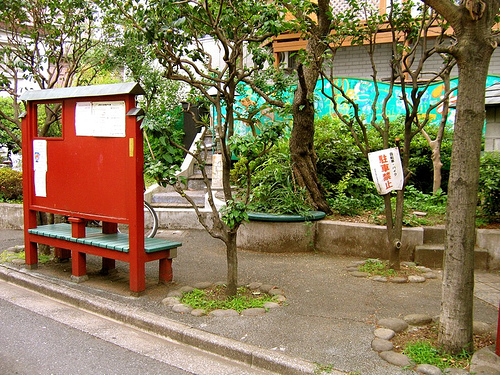
“Pocket park,” Ikebukuro, Tokyo
"东京池袋 "袖珍公园
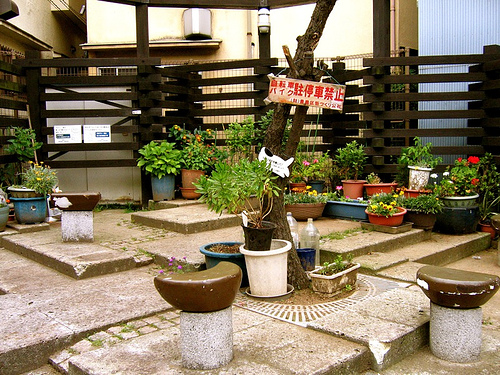
Another Ikebukuro “pocket park.” Of course you don’t have to make it this small. But you can if you want to!
池袋的另一个 "袖珍公园"。当然,你不一定非要把它做得这么小。但如果你愿意,你可以这么做!
One of the problems with Non-Space is that someone has to take care of it. All of that lawn and shrubbery and parking lot area needs to be maintained. Roads need to be plowed in winter. Usually this is not too difficult. But, just as nature abhors a vacuum, a Non-Place that is neglected soon fills up with something or other — trash, old automobiles and refrigerators, criminal activity, squatters, and so forth. One of the things about a Traditional City is that there is not really all that much space outside the buildings themselves. If Siena were in a snowy climate, for example, the roads could easily be cleared with hand shovels alone. In Japanese cities, many of which get lots of snow, it is traditional for each shopkeeper to shovel by hand the little bit of street in front of their store. If the street is sixteen feet wide (eight feet to the midpoint) and the storefront is thirty feet long, then they would have 8×30=240 square feet to shovel, which is nothing. (Actually it is traditional for shopkeepers to maintain the street in front of their store in all weather. Many will wash their little bit of pavement with a hose literally every single day.) Similiarly, a Traditional City is easier for a policeman to patrol because really the only open space is the Really Narrow Street, a little strip twelve feet wide, not acres and acres of asphalt and shrubbery.
非空间 "的问题之一是必须有人来打理。所有的草坪、灌木和停车场都需要维护。冬天需要犁地。通常这并不难。但是,正如大自然憎恶真空一样,一个被忽视的 "非场所 "很快就会被垃圾、旧汽车和冰箱、犯罪活动、寮屋等东西填满。传统城市的一个特点是,建筑物本身之外的空间其实并不大。例如,如果锡耶纳下雪,仅靠手铲就能轻松清理道路。在日本,许多城市都会下很多雪,按照传统,每个店主都要用手铲除店门口的一小块路面。如果街道宽 16 英尺(中点为 8 英尺),店面长 30 英尺,那么他们需要铲除的面积为 8×30=240 平方英尺,这根本不算什么。(事实上,店主们的传统做法是全天候维护店前的街道。很多人每天都会用水管冲洗他们的小路面)。同样,传统城市的警察也更容易巡逻,因为真正的开放空间只有一条 12 英尺宽的窄街,而不是数英亩的沥青路面和灌木丛。
The Traditional City can be maintained entirely with hand tools. You can build buildings and maintain streets and shovel snow all by hand — the way it has been done for hundreds and thousands of years. A lot of this suburban Non-Space can’t really be maintained without machines. Who is going to mow all that Green Space without a motorized lawnmower? (I can hear it already: “We’ll graze goats!”) Who could maintain all that pavement if they had to do it with cobblestones? Which says something about “sustainability” to those who are paying attention. Even a subway or train system can be built and maintained by hand, and in fact that is how it was originally done in the 19th century.
传统城市完全可以用手工工具来维护。你可以用手工建造建筑、维护街道、铲雪--千百年来一直是这样做的。如果没有机器,郊区的许多非空间就无法真正得到维护。没有电动割草机,谁来修剪这些绿地?(我已经听出来了:"我们要放牧山羊!")如果必须用鹅卵石铺设人行道,谁又能维护这些人行道呢?对于那些关注 "可持续发展 "的人来说,这说明了什么。即使是地铁或火车系统,也可以由人工建造和维护,事实上,19 世纪最初就是这样做的。
We described earlier the failed pattern of City Design that we called the Hypertrophic City. You can understand the failure of the Hypertrophic City by way of Place and Non-Place. The Hypertrophic City typically consists of very large buildings surrounded by very large roadways and plenty of Green Space. Although the buildings are very large, typically the land area occupied by the building itself is a relatively small amount of the overall space available — perhaps 10%-20%. Except for the occasional swimming pool, everything outside the buildings consists of Non-Place, in the form of Green Space, giant roadways, and (sometimes) parking lots. The only thing to do is to get in a car and go to another megabuilding somewhere. Does that sound like Dubai or Las Vegas?
我们在前面描述了失败的城市设计模式,我们称之为 "肥厚型城市"。你可以通过 "场所 "和 "非场所 "来理解 "富营养化城市 "的失败。富营养化城市通常由非常大的建筑物组成,周围环绕着非常大的道路和大量绿地。虽然建筑物非常大,但建筑物本身所占的土地面积通常只占整个可用空间的 10%-20%。除了偶尔出现的游泳池,建筑外的一切都由绿地、巨大的道路和(有时)停车场等 "非空间 "组成。唯一能做的就是坐上汽车,去其他地方的巨型建筑。听起来像迪拜或拉斯维加斯吗?
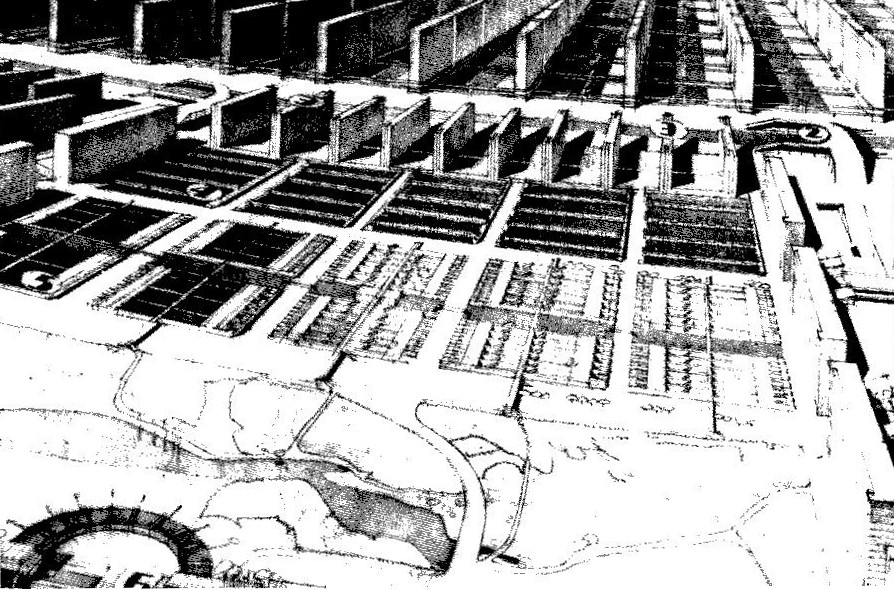
Richard Neutra’s Rush City Transformed, from 1928. Ninety percent Non-Space, combined with some sterile megabuildings. You don’t even have to build it to know that the result is going to be 90% suckitude, and the remaining 10% mega-sterile. It’s inevitable.
理查德-纽特拉(Richard Neutra)于 1928 年设计的 "匆忙城市改造"(Rush City Transformed)。90%的非空间与一些毫无生气的巨型建筑相结合。你甚至不需要建造它,就能知道其结果将是 90% 的烂尾楼和剩下的 10% 毫无生气的巨型建筑。这是不可避免的。
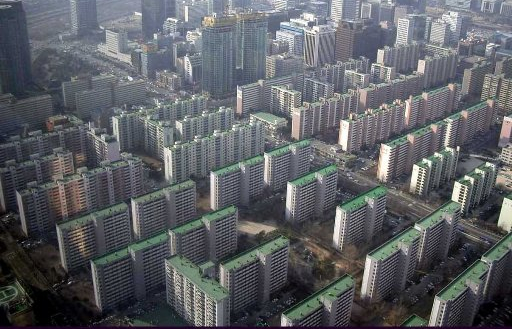
Part of Seoul, South Korea. Actually, Seoul is a vastly underappreciated city, with many Tokyo-like Traditional City-type neighborhoods that are lots of fun. This district, however, just goes to prove that all Hypertrophic Cities suck the same way. Despite the megabuildings, it is not even all that dense. If you built the whole thing Traditional City-style, four stories high with Really Narrow Streets like Florence, I bet you would end up with more total floor space.
韩国首尔的一部分。实际上,首尔是一座被严重低估的城市,这里有许多类似东京的传统城市型街区,非常有趣。然而,这个地区恰恰证明了所有肥胖城市都一样糟糕。尽管这里有巨型建筑,但密度并不高。如果像佛罗伦萨那样,把整个街区建成传统城市风格,四层楼高,街道非常狭窄,我敢打赌,总建筑面积会更大。
We will talk more about the specifics of incorporating vegetation and naturalistic elements — parks, sports fields, gardens, courtyards etc. — into the Traditional City in the future.
关于在传统城市中融入植被和自然元素--公园、运动场、花园、庭院等--的具体细节,我们将在今后进一步讨论。
Other comments in this series:
本系列的其他评论:
September 28, 2009: Let’s Take a Trip to Barcelona
2009 年 9 月 28 日我们去巴塞罗那旅行吧
September 20, 2009: The Problem of Scarcity 2: It’s All In Your Head
2009年9月20日稀缺问题 2:全在你的一念之间
September 13, 2009: The Problem of Scarcity
2009 年 9 月 13 日稀缺性问题
July 26, 2009: Let’s Take a Trip to an American Village 3: How the Suburbs Came to Be
2009 年 7 月 26 日美国乡村之旅 3:郊区是如何形成的
July 19, 2009: Let’s Take a Trip to an American Village 2: Downtown
2009 年 7 月 19 日美国乡村之旅 2:市中心
July 12, 2009: Let’s Take a Trip to an American Village
2009 年 7 月 12 日让我们一起去美国乡村旅行吧
May 3, 2009: A Bazillion Windmills
2009 年 5 月 3 日亿万风车
April 19, 2009: Let’s Kick Around the “Sustainability” Types
2009 年 4 月 19 日让我们一起探讨 "可持续性 "类型
March 3, 2009: Let’s Visit Some More Villages
2009 年 3 月 3 日再去几个村庄看看
February 15, 2009: Let’s Take a Trip to the French Village
2009 年 2 月 15 日法国村之旅
February 1, 2009: Let’s Take a Trip to the English Village
2009 年 2 月 1 日我们去英国村旅行吧
January 25, 2009: How to Buy Gold on the Comex (scroll down)
2009 年 1 月 25 日:如何在交易所购买黄金(向下滚动)
January 4, 2009: Currency Management for Little Countries (scroll down)
2009 年 1 月 4 日小国的货币管理(向下滚动)December 28, 2008: Currencies are Causes, not Effects (scroll down)
2008 年 12 月 28 日货币是因,不是果(向下滚动)December 21, 2008: Life Without Cars
2008 年 12 月 21 日没有汽车的生活
August 10, 2008: Visions of Future Cities
2008 年 8 月 10 日未来城市的愿景
July 20, 2008: The Traditional City vs. the “Radiant City”
2008 年 7 月 20 日传统城市与 "辐射城市 "之争
December 2, 2007: Let’s Take a Trip to Tokyo
2007 年 12 月 2 日我们去东京旅行吧
October 7, 2007: Let’s Take a Trip to Venice
2007 年 10 月 7 日威尼斯之旅
June 17, 2007: Recipe for Florence
2007 年 6 月 17 日佛罗伦萨食谱
July 9, 2007: No Growth Economics
2007 年 7 月 9 日无增长经济学
March 26, 2006: The Eco-Metropolis
2006 年 3 月 26 日生态大都会
* * *
Collapsing Fisheries Watch:
崩溃的渔业观察:
Good article from the New Republic:
来自《新共和》的好文章:
The jig, however, is nearly up. In 1950, the newly constituted Food and Agriculture Organization (FAO) of the United Nations estimated that, globally, we were catching about 20 million metric tons of fish (cod, mackerel, tuna, etc.) and invertebrates (lobster, squid, clams, etc.). That catch peaked at 90 million tons per year in the late 1980s, and it has been declining ever since. Much like Madoff’s infamous operation, which required a constant influx of new investments to generate “revenue” for past investors, the global fishing-industrial complex has required a constant influx of new stocks to continue operation. Instead of restricting its catches so that fish can reproduce and maintain their populations, the industry has simply fished until a stock is depleted and then moved on to new or deeper waters, and to smaller and stranger fish. And, just as a Ponzi scheme will collapse once the pool of potential investors has been drained, so too will the fishing industry collapse as the oceans are drained of life.
然而,钓钩已经快被钩住了。1950 年,新成立的联合国粮食及农业组织(FAO)估计,全球鱼类(鳕鱼、鲭鱼、金枪鱼等)和无脊椎动物(龙虾、鱿鱼、蛤蜊等)的捕获量约为 2000 万吨。20 世纪 80 年代末,捕捞量达到每年 9000 万吨的峰值,此后一直在下降。就像麦道夫臭名昭著的经营活动需要不断有新的投资流入才能为过去的投资者带来 "收益 "一样,全球渔业综合体也需要不断有新的鱼种流入才能继续经营。该行业不是限制捕捞量,使鱼类能够繁殖并维持其数量,而是简单地捕捞,直到鱼群枯竭,然后转到新的或更深的水域,捕捞更小、更陌生的鱼类。正如庞氏骗局的潜在投资者一旦被榨干就会崩溃一样,捕鱼业也会随着海洋生物的枯竭而崩溃。Unfortunately, it is not just the future of the fishing industry that is at stake, but also the continued health of the world’s largest ecosystem. While the climate crisis gathers front-page attention on a regular basis, people–even those who profess great environmental consciousness–continue to eat fish as if it were a sustainable practice. But eating a tuna roll at a sushi restaurant should be considered no more environmentally benign than driving a Hummer or harpooning a manatee. In the past 50 years, we have reduced the populations of large commercial fish, such as bluefin tuna, cod, and other favorites, by a staggering 90 percent. One study, published in the prestigious journal Science, forecast that, by 2048, all commercial fish stocks will have “collapsed,” meaning that they will be generating 10 percent or less of their peak catches. Whether or not that particular year, or even decade, is correct, one thing is clear: Fish are in dire peril, and, if they are, then so are we.
不幸的是,这不仅关系到捕鱼业的未来,也关系到世界上最大生态系统的持续健康。虽然气候危机经常成为头版头条,但人们--即使是那些自称具有很强环保意识的人--仍在继续吃鱼,好像这是一种可持续的做法。但是,在寿司店吃一个金枪鱼卷的环保程度不应该比开一辆悍马车或用鱼叉叉海牛的环保程度高。在过去 50 年里,蓝鳍金枪鱼、鳕鱼等大型商业鱼类的数量锐减了 90%。发表在著名杂志《科学》上的一项研究预测,到 2048 年,所有商业鱼类种群都将 "崩溃",这意味着它们的产量将只有高峰期的 10%或更少。无论那一年甚至那十年的预测是否正确,有一点是明确的:鱼类正处于水深火热之中,如果它们是这样,那么我们也一样。
This article is good, but actually the situation is much, much worse than you think. I’ll recommend again:
这篇文章很好,但实际上情况比你想象的要糟糕得多。我再次推荐:
The Unnatural History of the Sea, by Callum Roberts
海洋的非自然历史》,卡勒姆-罗伯茨著
* * *
Here’s an item of mine that ran in the Huffington Post:
下面是我在《赫芬顿邮报》上发表的一篇文章:

